|
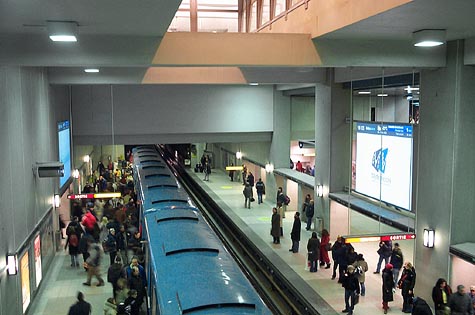 |
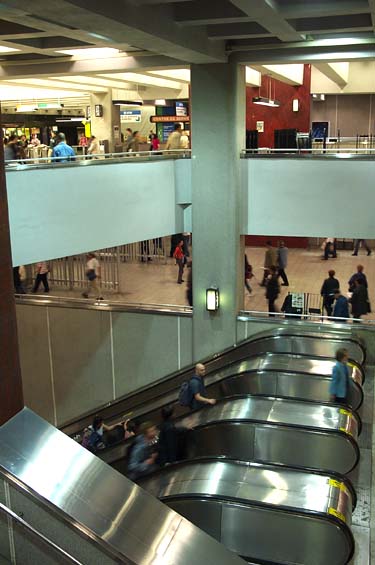 This is the largest station in the network, spanning three lines, and serves as the hub of STM customer service. To accomodate these functions, the main part of the station was built in a massive cross-shaped cut-and-cover volume underneath boul. de Maisonneuve and rue Berri. The pit was so large that the station's pillars actually had to be built to hold up the road above.
This is the largest station in the network, spanning three lines, and serves as the hub of STM customer service. To accomodate these functions, the main part of the station was built in a massive cross-shaped cut-and-cover volume underneath boul. de Maisonneuve and rue Berri. The pit was so large that the station's pillars actually had to be built to hold up the road above.The four corners of the cross contain the escalator wells that allow passengers both to transfer between lines and to quickly diffuse down among the lines from the central ticket hall. A concourse under the orange line connects both directions on that line with the Honoré-Beaugrand platform as well as with the main stairwell towards the yellow line. To the north, the stairs towards the Angrignon platform end in large volumes on either end of the platform, with the western volume connecting to the yellow line. Additional stairwells connect the Côte-Vertu and Angrignon platforms as well as the Honoré-Beaugrand platform and the yellow line.
The main volume of the station can be seen in the massive space above the green line platform, overlooked from the orange line landings. Like the rest of the walls in the station, the high walls of the platform are done in muted grey circular tiles, and unfortunately their expanse is easy prey for advertisers who cover whole square dekameters with garish billboards.
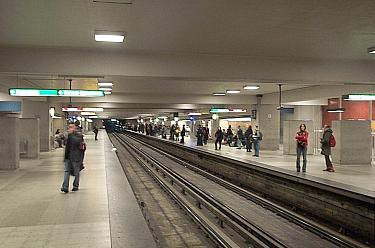 |
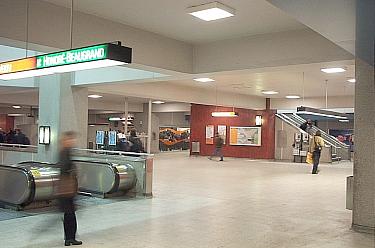 |
 The orange line crosses through the green line's high space. The low ceilings of the platform are compensated for by the open areas above the two wide landings on either side of the tracks, which join the escalator wells on either side and permit efficient traffic flow. Also, the glass walls looking out from the platforms over the stairwells are decorated with wavy orange stripes.
The orange line crosses through the green line's high space. The low ceilings of the platform are compensated for by the open areas above the two wide landings on either side of the tracks, which join the escalator wells on either side and permit efficient traffic flow. Also, the glass walls looking out from the platforms over the stairwells are decorated with wavy orange stripes.

At the top of the station, and at the central point of the cut-and-cover cross, is the central concourse and ticket hall. This wide open space, with banks of turnstiles on all four sides, gives access to the four escalator wells.
At its centre is a black granite circular bench, popularly called "la pilule" (the pill) or "la rondelle" (the puck); set into it is a circular plaque by Robert LaPalme and Georges Lauda commemorating the inauguration of the metro. The "rondelle" is a popular meeting spot and is usually surrounded by UQAM students.
Another monument, on one of the supporting pillars, commemorates the 25th anniversary of the metro; it encloses a time capsule.
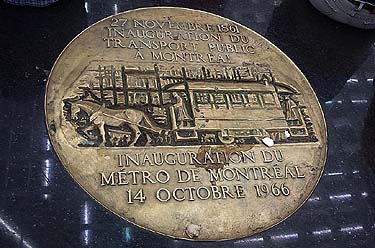 |
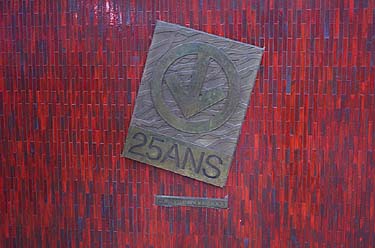 |
The concourse is ringed with corridors, which contain a number of shops and services including the STM's customer information counter.
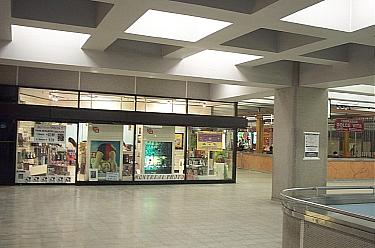 |
 |
From the centre, four corridors radiate out above the station's volume towards the entrances. In addition, four accesses (to the rue Berri entrance, to the Grande Bibliothèque, and two to UQAM's Judith-Jasmin pavillion) open into the central concourse.
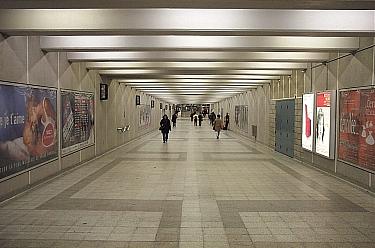 |
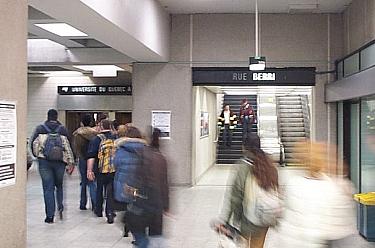 |
Three of these four corridors used to have openings looking down onto the orange and green line platforms, allowing dramatic vistas into the station's great volume. Unfortunately, a tear-gas attack in this station in 2001 demonstrated the need to close these, as they allowed the gas to rapidly disperse into all parts of the station. This would be especially dangerous in case of fire.
One of the openings was closed and replaced with a restaurant terrace; happily, the other two have been kept open but glassed off, preserving the view while respecting safety requirements.
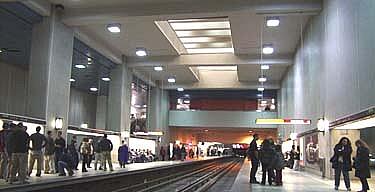 Former opening above the green line trainroom |
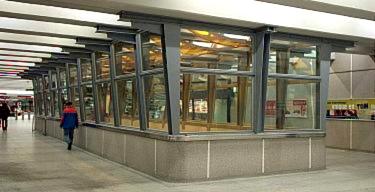 |

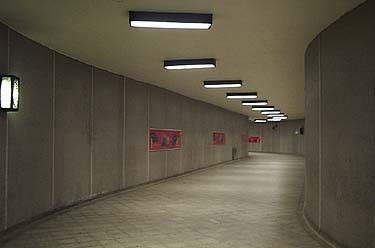 The deepest part of the station, the yellow line terminus, is not built within the great volume; instead, it is built in a mined tunnel under rue Saint-Denis. The platform is brightened by yellow, brown, and light blue tiled motifs.
The deepest part of the station, the yellow line terminus, is not built within the great volume; instead, it is built in a mined tunnel under rue Saint-Denis. The platform is brightened by yellow, brown, and light blue tiled motifs.
The terminus is joined to the rest of the station by two staircases to the western end of the green line, as well as a long corridor to the main staircase. These corridors, all done in dull, unbroken grey, are frankly tedious. However, the top of the stairs to the terminus has recently been brightened (and some water damage concealed) by a new mural, Le mur de la paix. This work, in colours matching the tiling on the yellow line platforms, features the word "peace" written in many different languages.
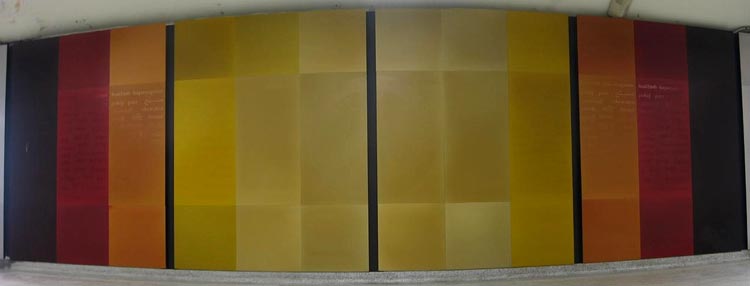
Along with Lionel-Groulx, this was among the first two stations besides the ones in Laval to have elevators added; they were opened on 14 September 2009. Two elevators connect the orange line platforms to the mezzanine. Currently, elevators in the Grande Bibliothèque and UQAM's Pavillon Judith-Jasmin provide access to the mezzanine from the street; a third elevator is planned for the Saint-Denis exit. Currently, only the orange line is accessible.
 |
 |
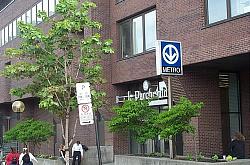 |
 |
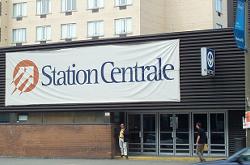 |
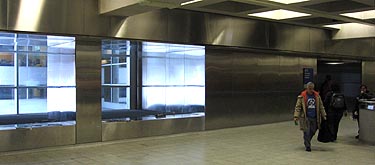 Back up to ground level, all but one of the entrances are integrated into other buildings - two UQAM pavilions, the Station centrale d'autobus, and the Place Dupuis shopping mall. The completion of the Grande Bibliothèque du Québec has added another one, bringing natural light to the concourse for the first time via a sunken garden.
Back up to ground level, all but one of the entrances are integrated into other buildings - two UQAM pavilions, the Station centrale d'autobus, and the Place Dupuis shopping mall. The completion of the Grande Bibliothèque du Québec has added another one, bringing natural light to the concourse for the first time via a sunken garden.
The one freestanding entrance building at Berri and Sainte-Catherine in place Émilie-Gamelin (a.k.a. Berri Square) was rebuilt in 1999 in the same postmodern style as the new entrances at Beaudry, Papineau, and Frontenac, the next three stations down the line. It is surprisingly tall for a metro entrance, with a second story containing ventilation works, and is done in glass and brushed steel.
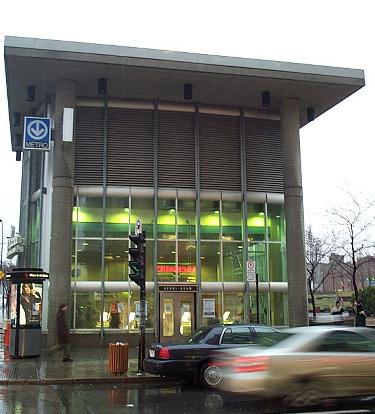 |
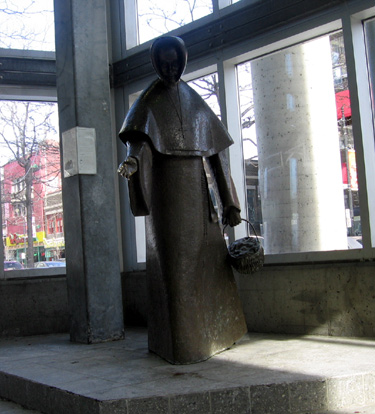 |
This entrance houses a statue by Raoul Hunter of Mother Émilie Gamelin, the namesake of the square in which the entrance stands. It is one of only two figurative statues in the metro, the other being the statue of Jacques Cartier at Place-Saint-Henri.
The statue is one of three main works in this station. Another is a set of murals by Robert LaPalme above the main staircase leading to the yellow line, through which tourists from Montreal had to pass to get to the Man and His World exhibits of Expo '67 on Île Sainte-Hélène. Moved here by special request of Mayor Jean Drapeau after their former home, the main pavillion of Man and His World, was closed, they symbolically depict science, culture, and recreation, the major themes of that exposition. They are the only oil paintings in the metro.
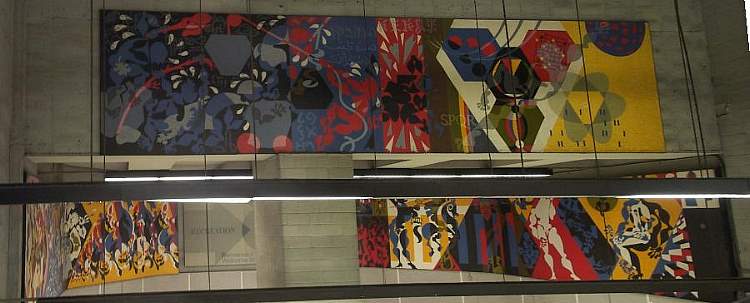
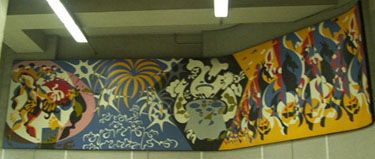 |
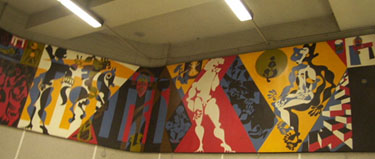 |
Finally, the most prominent and eye-catching artwork in the station is the huge stained-glass mural on the eastern end of the green-line trainroom. The work, Hommage aux fondateurs de la ville de Montréal by Pierre Gaboriau and Pierre Osterrath, represents three people who were instrumental in the foundation of Montreal: Jérôme le Royer de la Dauversière, who bought the island for the colony; Jeanne Mance, the founder of the Hôtel-Dieu; and Paul Chomedey, sieur de Maisonneuve, the colony's first commander.
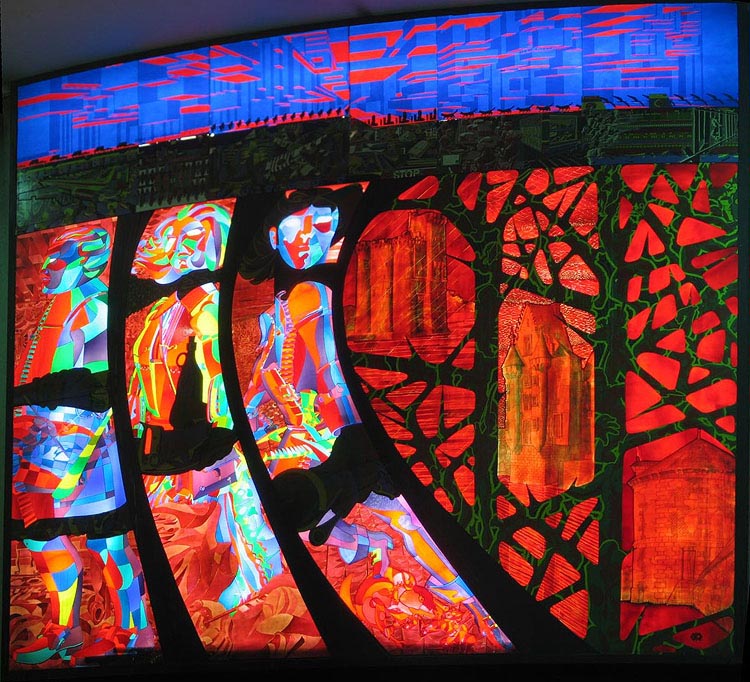
The work, which extends from immediately above the mouth of the tunnel to the ceiling of the volume, is in shades of red and blue and is very modern and abstract. This shows the rebellion of the main current of Quebec art at the time of its creation against the rules imposed by Robert LaPalme for art in the metro.
As art director for the metro, LaPalme's plan was to have all the artwork in the metro be figurative and depict the history of Montreal. His son, an artist in his own right, was chosen to create this mural; but he was so irritated by his father's stance that he stretched the figurative aspect as far as it would go, and signed the work with the assumed name Gaboriau.
| ||